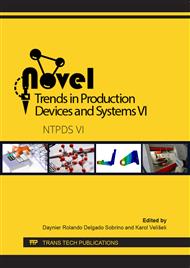p.248
p.256
p.265
p.272
p.280
p.288
p.296
p.304
p.312
The Materials and Technologies Used in the Process of Developing a Rotary Module with an Unlimited Degree Rotation
Abstract:
The article deals with the process of the development of components, selection and use of materials required to assemble an universal rotation module. The use of the right materials and production processes is an important factor in the development of any new machines. The paper first describes the function of the universal rotation module. Furthermore, it focuses on the development process of selected parts of the prototype, especially the outer cover of the module as well as other important parts. The main problem is to correctly design and manufacture the module so that the engine and other mechanical parts can be placed inside. The technologies that were used in the development of the rotary module are metal machining and plastic printing by additive technology. It also deals with materials that were used in the production of the first generation of the functional prototype and in the development and testing in the pre-production phase.
Info:
Periodical:
Pages:
288-295
Citation:
Online since:
May 2020
Authors:
Keywords:
Price:
Сopyright:
© 2020 Trans Tech Publications Ltd. All Rights Reserved
Share:
Citation:


